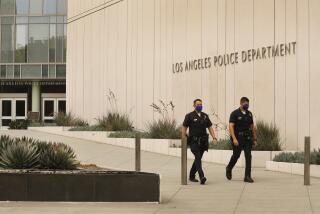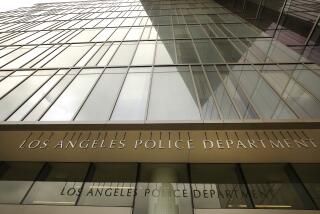The Fight Against Crime: Notes From The Front : Ruling Hinders Photographing of Suspects
Police officers have long tried to find ways to stem gang violence through compiling a list of suspected members. One of those methods has been to snap photos of people they believe might be in a gang.
Officers often use the photos of detained suspects to build files on gangs throughout the city.
But a recent court decision makes it more difficult for officers to photograph those they suspect of gang activities.
In July 1993, two 15-year-old girls of Vietnamese descent, students from Little Saigon in Orange County, said they were illegally detained by police at a shopping mall in Garden Grove. They were photographed by officers who allegedly suspected the two honor-roll students of belonging to a gang. With backing from the American Civil Liberties Union and a few local Asian community groups, the students sued the department on civil rights violations and won an $85,000 settlement.
The new decision now requires officers to submit to their superiors a written justification for stopping suspects and a specific crime. Officers must also secure the permission of the person in order to take their picture, unless they are arrested.
Before the settlement, officers could use their own judgment about whether they had sufficient grounds to photograph an individual.
Part of the decision also allows people who have involuntarily had their photo taken to file a petition to have it removed from police files. And if police decline to release the photographs, a three-member independent panel will then review the challenge to judge the validity of police refusal.
For experienced gang-violence investigators such as Det. Sam Masuda of the Asian crimes section, the decision simply requires better policing of their patrol areas by officers. Masuda, who has spent years working with Asian gangs in Los Angeles, said that although police sometimes use clothes to gauge potential suspects, it is both unfair and often misleading to make a stop because of clothing.
“You can’t go by that nowadays,” Masuda said. “A lot of the kids dress similarly. We can’t judge by cars or clothes. And it has to be more than just standing on a street corner or at a bus stop. The people we stop are usually ones we recognize from the past or who we know are repeat offenders or on probation.”
Masuda said officers know that “it’s not illegal to be a gang member” and even when they do stop youths they know are in a gang, they usually have a reason or at least a particular crime in mind to necessitate a photo or questioning the person.
Police spokeswoman Cherie Clair said it is rare that police stop residents who they don’t strongly suspects are involved in gangs. In most cases, a core of officers patrols the same neighborhoods frequently, usually getting to know the gang members.
“Most of the time, officers build a relationship with the gang members in their areas,” Clair said. “When officers ask if they are gang members, a lot of them admit to it. It’s usually the younger ones who are a little scared of getting in trouble. But most are proud of their gang.”
Police Lt. Fred Tular of the Valley’s Community Resources Against Street Hoodlums, or CRASH Unit, said the time of day, who the person is hanging out with, and the location all play into whether officers decide to take a photo.
And with more youths of all backgrounds sporting baggy pants, white T-shirts or other attire commonly associated with gangs, police said it has become increasingly difficult to separate the gang members from kids who just want to be cool. But since Tular says “all photos are consensual,” suspected gang members can always deny gang membership and refuse to have their picture taken.
More to Read
Sign up for Essential California
The most important California stories and recommendations in your inbox every morning.
You may occasionally receive promotional content from the Los Angeles Times.










